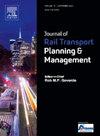Using Time Signal at Red (TSAR) as a tool for analysing rail network performance
IF 2.7
Q3 TRANSPORTATION
Journal of Rail Transport Planning & Management
Pub Date : 2025-01-31
DOI:10.1016/j.jrtpm.2025.100505
引用次数: 0
Abstract
Reactionary delays can adversely impact train service performance. This is particularly true for parts of the rail network at or near capacity. To detect the causes of such delays, a metric with a granularity smaller than those of typical rail delay metrics is required. We present an approach based on the Time Signal at Red (TSAR) metric. The purpose of TSAR is to measure the duration a berth is continuously occupied by a train or reserved, which is closely related to information regarding the red aspect of the berth signal at an entrance to the berth. Thus, TSAR provides a low-level metric to measure individual service and berth performance, and to observe system effects that reflect reactionary delay. The paper defines TSAR and describes a data processing methodology to extract TSAR and signal aspect on berth entry from disparate data sources. The use of TSAR is demonstrated for a case study area – comparing different service patterns, identifying patterns of reactionary delay, and showing the impact of adhesion at different times of year. The implications of TSAR are discussed, including its utility for applications such as analysis of simulated network performance.
使用红灯时信号(TSAR)作为分析铁路网性能的工具
被动延误会对列车服务性能产生不利影响。对于部分已满负荷或接近满负荷的铁路网来说,情况尤其如此。为了检测这种延迟的原因,需要一个粒度小于典型铁路延迟度量的度量。我们提出了一种基于时间信号在红色(TSAR)度量的方法。TSAR的目的是测量一个泊位连续被列车占用或预留的时间,这与泊位入口的泊位信号的红色方面的信息密切相关。因此,TSAR提供了一个低级的度量来衡量单个服务和泊位的性能,并观察反映反动延迟的系统效应。本文定义了TSAR,并描述了一种从不同数据源中提取TSAR和信号方面的数据处理方法。在案例研究领域中演示了TSAR的使用-比较不同的服务模式,识别反应延迟的模式,并显示一年中不同时间粘附的影响。讨论了TSAR的含义,包括其在模拟网络性能分析等应用中的效用。
本文章由计算机程序翻译,如有差异,请以英文原文为准。
求助全文
约1分钟内获得全文
求助全文
来源期刊

Journal of Rail Transport Planning & Management
TRANSPORTATION-
CiteScore
7.10
自引率
8.10%
发文量
41
 求助内容:
求助内容: 应助结果提醒方式:
应助结果提醒方式:


